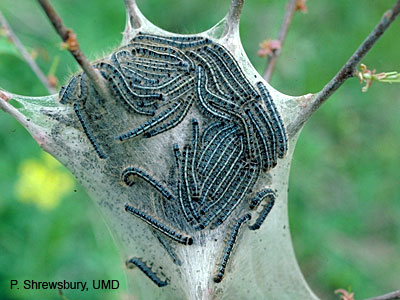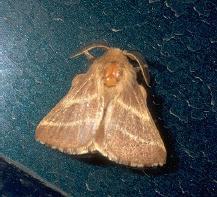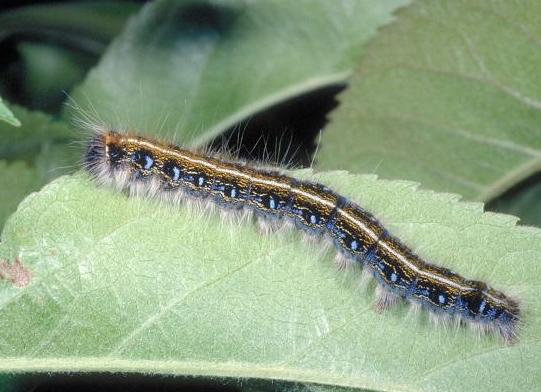Camping with the Tent Caterpillars
By Ray Novitske, Fairfax Master Gardener
 Almost everyone has seen their webbing in the branch crotches of trees around this time of year. When you take a close look, you don’t see many tent caterpillars in the tent, but the tent continues to grow. Like we do on a camping trip, they stay in their tents during the night and on rainy days, and usually hike out to roam around during the day. These are the habits of the Eastern Tent Caterpillar (Malacosoma americana).
Almost everyone has seen their webbing in the branch crotches of trees around this time of year. When you take a close look, you don’t see many tent caterpillars in the tent, but the tent continues to grow. Like we do on a camping trip, they stay in their tents during the night and on rainy days, and usually hike out to roam around during the day. These are the habits of the Eastern Tent Caterpillar (Malacosoma americana).
Life Cycle
The caterpillars start their life hatching from eggs near the time of tree bud growth in March and April. The young larvae, being as sociable as we are, gather together near the fork of the tree limb to begin spinning their web or tent. This is used for protection from birds and the elements as they mature. The tents are unsightly, but rarely cause significant damage to the trees.
Caterpillars eat the leaves on the tree, but seldom cause the tree’s demise. Trees usually recover unless the tree is young or weakened and stressed from other problems. The caterpillars’ favorite foods are all types of cherry trees, hawthorn, crabapple and fruit trees.
The caterpillars bed down in the night and leave their tents during daytime to find food and munch away in the trees. They are fully grown in about four to six weeks, reaching about 2 inches in length. And when fully grown, they crawl to building cracks or nearby protected places to spin their cocoons. In another three weeks, the moths emerge and take wing to mate.

adult moth
Tent caterpillars look very similar to gypsy moths, but they are subtly different in appearance and habit. The Eastern Tent Caterpillar can be identified by the white stripe running down its back, while the gypsy moth caterpillar has red spots down its back and no stripe. Gypsy moth caterpillars also do not live in tents.
Control
 If you can find the egg masses around the twigs, you can destroy them, but the eggs are frequently higher in a tree than our easy reach. If you physically destroy the tents, the caterpillars are exposed to birds and the weather. Birds find the tasty caterpillars a protein treat for their young. The caterpillars are also easily controlled by nature and the weather. They are a target for parasitic wasps and succumb to disease.
If you can find the egg masses around the twigs, you can destroy them, but the eggs are frequently higher in a tree than our easy reach. If you physically destroy the tents, the caterpillars are exposed to birds and the weather. Birds find the tasty caterpillars a protein treat for their young. The caterpillars are also easily controlled by nature and the weather. They are a target for parasitic wasps and succumb to disease.
They can be controlled with early spraying of pesticides, but these are only effective when the caterpillars are young. Bt, a bacteria that cause infections in caterpillars, is the safest. Once the little rascals are older, pesticides are ineffective. And while in the webs, the caterpillars are protected, so spray foliage during the day with a pesticide that will remain there. We may have heard ways to control the caterpillars by setting fire to their tent. This is not recommended, since the caterpillars are out and about during the day when we would set fire, and fire will cause damage to the tree limbs as the tent burns.
This is one of the easiest pests to control without pesticides. And by destroying their tent protection, you also help our feathered friends.
References
Eastern Tent Caterpillar, Eric Day, Virginia Tech Insect Identification Laboratory
Eastern Tent Caterpillar, University of Florida School of Forest Resources & Conservation
Eastern/Forest Tent Caterpillars – Trees, University of Maryland Extension
Eastern Tent Caterpillar, Ric Bessin, University of Kentucky College of Agriculture
Eastern Tent Caterpillar, North Carolina State Extension
… updated 2022